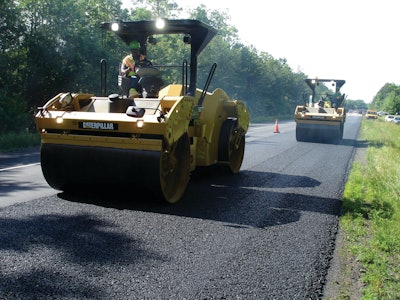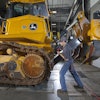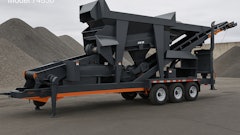
We define amplitude, when referring to vibratory asphalt compactors, as the distance the drum moves into the mat. The weight of the drum, combined with drum movement, delivers impact force into the asphalt layer in order to reduce air voids and accelerate the densification process. The goal of the compactor operator, supervisor or quality control person is to select the maximum amplitude that the mat will accept without creating drum bouncing.
Most modern asphalt compactors have two or more amplitudes. The compactor operator must know equipment capabilities and how to set up the machine for each amplitude setting. No matter how many amplitudes are available on a compactor, they are classed in the following manner.
Low Amplitude Medium Amplitude High Amplitude
0.25-0.48 mm / 0.49-0.74 mm / 0.75 mm or higher/
0.010-0.019” 0.020-0.029” 0.030” or higher
Selecting the correct amplitude should be approached as methodically as possible for each phase of compaction, especially the breakdown phase that creates the majority of the target density. If the amplitude (impact force) is too low during the breakdown phase, the common results are: insufficient density, the need for too many repeat passes, and inability to keep up with the paver’s production. If the amplitude is too high, there is a risk of: fracturing aggregates, losing density, and leaving impact marks in the fresh mat.
As a guide to help you select the correct amplitude during the breakdown phase, here are eight questions to answer when setting up the test strip or before beginning to work on any project. The answers to the questions are given a numerical value, based on each answer’s potential influence on amplitude selection.
1. Lift Thickness
In general, the thicker the asphalt layer the more force you can apply without damaging the layer or creating drum bouncing. A basic way to relate amplitude to layer thickness is to use these classifications:
Layer Thickness Amplitude Numeric Value
Less than 5 cm / 2” Low -1
5 – 7.5 cm / 2-3” Medium 0
More than 7.5 cm /3” High 1
2. Type of Mix
The type of mix affects the amount of impact force that can be accepted without damage to the mat. Dense graded mixes tend to accept more force because there are a variety of aggregate sizes that help absorb the compaction energy. So, as you are creating your checklist of factors, you can think about using higher amplitude for dense-graded mixes. Open, or gap-graded, mixes tend to be more fragile and will be damaged more easily than dense-graded mixes if too much impact force is applied. Likewise, stone mastic asphalt (SMA) designs generally will not tolerate high force and you should be thinking about lower amplitude selection.
Mix Design Numeric Value
Dense-graded 1
Open / Gap-graded -1
SMA -1
3. Maximum Aggregate Size
Mixes with nominal aggregate size 19 mm (3/4”) or larger are classed as coarse or harsh mixes. Usually, it takes more force to move the large aggregate into close contact and drive out most of the air voids. Select medium or high amplitude when compacting large stone mixes. Mixes with nominal aggregate size 13 mm (1/2”) or smaller are classed as fine or tender mixes. The amplitude setting should be in the low or medium range when compacting fine mixes.
Aggregate Size Numeric Value
>19 mm (3/4”) 1
12-19 mm(1/2”-3/4”) 0
4. Ratio of Aggregate Size to Layer Thickness
The ratio of nominal aggregate size to layer thickness has a major influence on amplitude selection. The minimum design standard calls for a 3:1 ratio. In other words, if the nominal aggregate size is 25 mm (1.0”), the minimum layer thickness should be 75 mm (3.0”). A 3:1 ratio means that this factor is basically “neutral”. A 4:1 ratio means that there is more room for aggregate to move within the layer and that layer will accept more impact force without damage so you can consider using higher amplitudes. A 2:1 ratio means that there is not as much room for the aggregate to move within the layer. You will have to select lower amplitudes or operate in the static mode to avoid fracturing aggregates and creating drum bounce.
Ratio Numeric Value
4:1 1
3:1 0
2:1 -2
5. Aggregate Shape
The shape of the aggregates in a mix affects how easily the aggregates will re-orient, move into close contact, and interlock for strength. Some mix designs, most notably Superpave, require that aggregates have fractured, elongated faces. Those fractured faces create high internal friction within the asphalt layer and it takes more force to create stone-on-stone interlock. As long as there is an adequate ratio of layer thickness to aggregate size, set up for higher amplitudes when compacting mixes with angular shaped aggregates. Some mixes have aggregates with rounded faces. Those aggregates have low internal friction and move into close contact easily. Select lower amplitudes when there are aggregates with rounded faces.
Shape Numeric Value
Angular 1
Rounded 0
6. Asphalt Cement Viscosity
The viscosity of the asphalt cement used in a mix affects the stiffness of the mix. In general, asphalt cement that contains modifiers like polymers or latex have high viscosity and contribute to stiffness in the asphalt layers. More force is needed to compact mixes with modified asphalt cement. Unmodified asphalt cement, also called “neat” oil, has lower viscosity. A mix with unmodified asphalt cement, all other factors being equal, will compact under less force, or lower amplitude.
Viscosity Numeric Value
High 1
Low 0
7. Type of Base
The base over which the asphalt layer is being laid influences amplitude selection. A yielding base, such as compacted granular material, tends to absorb some of the compaction energy generated by a vibratory compactor. Therefore, select higher amplitude ranges when compacting the first lift on granular material. A rigid base, such as a milled surface or compacted asphalt, can contribute to drum bouncing, especially when compacting thin mats. Be aware of the need to reduce amplitude when compacting asphalt layers on rigid bases.
Base Numeric Value
Granular 2
Rigid -1
8. Ambient Temperature
Asphalt layers compact easier at high temperature. When the ambient temperature is relatively high, say above 20o C (70o F), the mat tends to stay hot longer and getting density is not negatively affected. When the ambient temperature is relatively low, less than 20o C (70o F), you may need to increase the amount of force used in order to get density more quickly. Increasing amplitude is one possibility to help get density faster when the ambient temperature is low.
Temperature Numeric Value
>20oC (>70 degrees F) 0
Using the Numeric Values
After answering the eight questions, add the numeric values assigned to each answer. Select an amplitude to use as a starting point based on the following chart.
If 5,6,7,8: high amplitude (0.75 mm / 0.030” or higher)
If 3,4: medium amplitude (0.50-0.75 mm /.020-.029”)
If 0,1,2: low amplitude (0.48 mm / 0.19” or lower)
If negative number: static or low amplitude with one drum vibe and one drum static
Project Example #1
To illustrate how to use the amplitude selection guidelines, let’s look at a project example. In the first instance, we are laying down a 25 mm (1.0”), dense-graded Superpave as the first lift on granular base. Uncompacted depth is 90 mm (3.5”). There are no modifiers in the asphalt cement and the ambient temperature is 25 degrees C (75 degrees F). Let’s substitute the numeric values for the eight project characteristics.
Factor Answer Value
Thickness 90 mm (3.5”) 1
Mix type Dense-graded 1
Size 25 mm (1.0”) 1
Ratio 3:1 0
Shape Angular 1
Viscosity Low 0
Base Granular 2
Temperature >20 degrees C (70 degrees F) 0
Total Value 6
Suggested amplitude is in the High range.
Project Example #2
Now, let’s look at a different project example. This time, we are laying down a 9 mm (3/8””), open-graded friction course as the wear lift on compacted asphalt. Uncompacted depth is 38 mm (1.5”). The asphalt cement contains no modifiers and the ambient temperature is 15 degrees C (50 degrees F). Let’s substitute the numeric values for the eight project characteristics.
Factor Answer Value
Thickness 38 mm (1.5”) -1
Mix type Open-graded -1
Size 9 mm (3/8”) -1
Ratio 4:1 1
Shape Angular 1
Viscosity Low 0
Base Rigid -1
Temperature
Total Value -1
Because the total value is a negative number, you will need to compact this layer in the static mode, or at most with the drums set to the lowest amplitude, one drum vibratory and one drum static.
Remember to use these amplitude selection guidelines as a starting point for machine setup. Always verify that you are creating the target density without damaging the asphalt layer. Once you have selected the correct vibratory characteristics and the proper pattern, document your work and then strive for consistency.




















